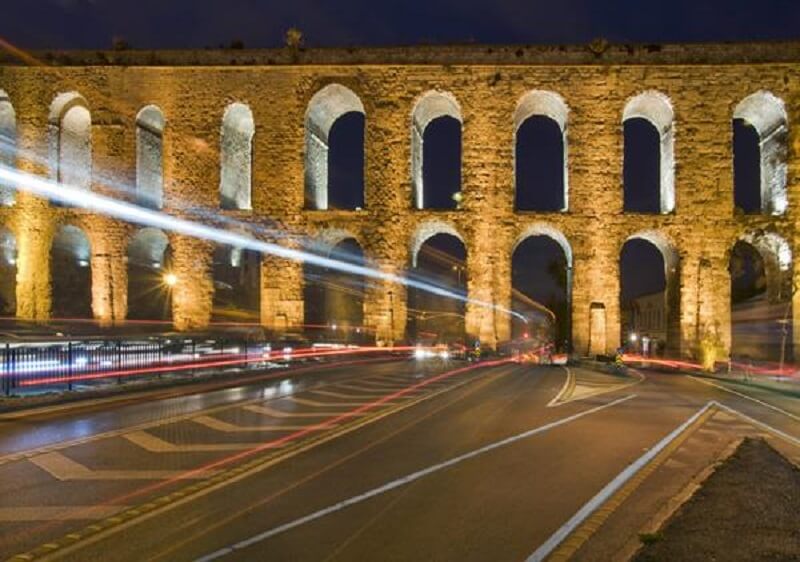
Valens Aqueduct Istanbul – When visiting Istanbul, one of the city’s most awe-inspiring sights is the Valens Aqueduct. Built nearly 1600 years ago during the reign of the Roman Emperor Valens, the aqueduct is a testament to the ancient Romans’ engineering prowess and remains one of the most impressive architectural achievements of the ancient world.
The Valens Aqueduct was constructed in the 4th century AD as a means to bring water to the city of Constantinople (modern-day Istanbul) from the springs located in Belgrade Forest, some 20 km away. The aqueduct consisted of a series of arches spanning over the streets and valleys of Istanbul, carrying water in a channel made of brick and stone. The channel was elevated and covered to protect the water from contamination and theft, and the aqueduct was capable of supplying the city with up to 100,000 cubic meters of water per day.
Despite its age, much of the Valens Aqueduct still stands today, making it one of the best-preserved ancient aqueducts in the world. When people go to Istanbul, they can look at the aqueduct’s tall arches that stretch across the city. These arches show how grand Roman engineering was back then.
Valens’ Aqueduct Architecture
In addition to its impressive engineering, the Valens Aqueduct is also known for its architectural beauty. The arches are adorned with intricate carvings, sculptures, and reliefs, giving the aqueduct a sense of grandeur and sophistication. Visitors can also admire the elegant stone carvings, featuring intricate geometric patterns, as well as the monumental inscriptions that commemorate the aqueduct’s construction and the emperor who commissioned it.
The Valens Aqueduct is located in the historic district of Fatih in Istanbul and can be easily accessed by public transportation or on foot. Visitors can walk along the aqueduct’s arches, taking in its grandeur and beauty, and admire the surrounding views of the city’s historic neighborhoods.
In conclusion, the Valens Aqueduct is a must-visit for anyone traveling to Istanbul. Its impressive engineering and architectural beauty make it one of the city’s most awe-inspiring sights, and its historical significance provides a glimpse into the ancient Roman world and the skill of its engineers. Whether you’re a history buff, an architecture enthusiast, or simply looking for an unforgettable experience, the Valens Aqueduct is a sight not to be missed.
What to See Around Valens’ Aqueduct
If you are visiting the Valens Aqueduct in Istanbul, there are several other notable sights and attractions that you can see nearby. Here are some suggestions:
Whether you are interested in history, architecture, shopping, or just soaking up the sights and sounds of Istanbul, there is something to see and do near the Valens Aqueduct. Be sure to plan and allocate enough time to explore all the attractions that interest you.
Q: What is Valens’ Aqueduct?
A: The Roman Emperor Valens constructed the Valens’ Aqueduct, a Roman aqueduct, in Istanbul, Turkey, in the fourth century AD.
Q: Where is Valens’ Aqueduct located?
A: The Valens’ Aqueduct is near the Basilica Cistern in the Fatih neighborhood of Istanbul.
Q: What is the history of Valens’ Aqueduct?
A: Valens’ Aqueduct was built to supply the city of Constantinople (now Istanbul) with fresh water from a spring located in the nearby hills. It was one of the oldest world’s biggest and most complex water systems.
Q: How does the aqueduct work?
A: The aqueduct is made up of arched stone bridges that carried water across valleys and underground pipes that carried water beneath city streets.
Q: What is the architectural style of Valens’ Aqueduct?
A: Valens’ Aqueduct is an example of Roman engineering and architecture, with its use of arches, columns, and stone masonry.
Q: What is the significance of Valens’ Aqueduct?
A: The Valens’ Aqueduct is thought to be one of the best examples of ancient engineering and water management. It is also a sign of the Roman Empire’s wealth and technological progress.
Q: What is the current condition of Valens’ Aqueduct?
A: Today, parts of the aqueduct are well preserved and open to visitors, while other sections have been damaged or destroyed over time.
Q: What is the length of Valens’ Aqueduct?
A: Valens’ Aqueduct is estimated to have been over 9 kilometers (5.5 miles) in length.
Q: What other aqueducts were built in Istanbul?
A: In addition to Valens’ Aqueduct, several other aqueducts were built in Istanbul, including the Aqueduct of Justinian and the Binbirdirek Cistern.
Q: Are there any similar aqueducts in the world?
A: There are many other ancient aqueducts throughout the world, including the Pont du Gard in France and the Acquedotto Claudia in Rome.
You can book an Istanbul city tour with our licensed tour guides. The links are below:
Private Guided Istanbul Tour I Private Guided Bosphorus Cruise Tour I 3 Days Private Guided Istanbul Tour Package I Istanbul Food Tour I Istanbul Asian Side Tour I Istanbul Layover Tour I Private Half-Day Guided Istanbul Old City Tour I Private Half-Day Guided Bosphorus Cruise I Private Half-Day Guided Istanbul Tour I Private Half-Day Guided Istanbul Historical Tour I Istanbul Islamic Heritages Tour I Istanbul Jewish Heritage Tour I Gallipoli Tour I Edirne Tour from Istanbul I Bursa Tour
Istanbul Tour Guide Baris I Istanbul Tour Guide Sanem I Istanbul Tour Guide Semih I Istanbul Tour Guide Ozgen I Istanbul Tour Guide Cem I Istanbul Tour Guide Hulya I Istanbul Tour Guide Murat I Istanbul Tour Guide Duygu
Map of Valens Aquaduct Istanbul